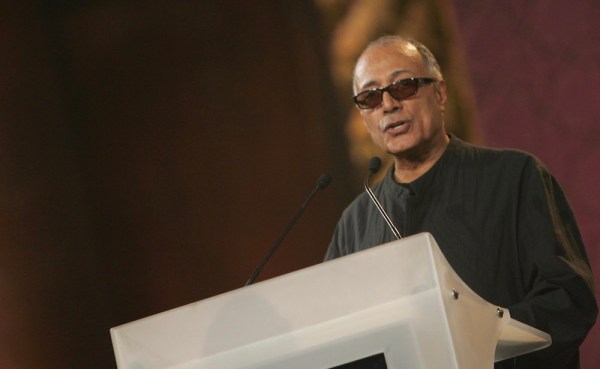
The phrase “deceptively simple” could have been invented to describe the films of Abbas Kiarostami, the Iranian director who died in Paris today at the age of 76 after a battle with cancer. Kiarostami made films defined by long takes that featured little in the way of showy camerawork. His trademark device was a conversation held by two people traveling in a car, which he would let play out at length with minimal cutting, often not even allowing a reaction shot to show how the character on the receiving end of the conversation was responding to what was being said. Yet, with these unassuming tools, Kiarostami used films to explore the politics of his native Iran, the most basic questions of life, and the nature of filmmaking and filmgoing, often creating movies whose reality folded in on itself.
Yet “deceptively simple,” beyond being a difficult-to-define-phrase, feels inadequate, implying that Kiarostami trafficked in tricks or enjoyed playing games. His films never had that quality. Even when they took turns toward the meta, as they did with increasing frequency as his career progressed, they felt like natural expressions of a curious mind attempting to puzzle out what it means to be be a woman in Tehran at the turn of the 20th century, as in the 2002 film Ten, or capturing the first stirrings of a defying authority, as in the 1987 film Where is the Friend’s Home?, or attempting to understand the decision to live or die, as in has Palme D’Or-winning 1997 film Taste of Cherry.
Kiarostami’s career stretched back to the 1960s and had its roots in advertising. He began making films in the 1970s, part of a flowering of Iranian filmmaking that would first start attracting world attention in the 1980s. Kiarostami’s films were among those that helped attract attention to what was happening in Iranian cinema thanks in part to the festival success of Where is the Friend‘s Home? The film tells story of a grade school boy who accidentally brings his friend’s homework home with him, then tries to return it lest his friend be punished. It’s a simple story with hidden depths, part of a larger tradition of Iranian films using stories of children to make a larger point.
It also seemed to establish Kiarostami as a natural heir to the neo-realist tradition, but he had other plans. Where is the Friend’s Home? became the first installment of what would be known as the Koker Trilogy, after the Northern Iran village in which they were filmed. Each one stepped back from the reality of that film a little further. In the 1991 film Life and Nothing But…, Kiarostami fictionalized his own search for the stars of Where is the Friend’s Home? following a devastating earthquake. The 1994 film Through the Olive Trees pulls back even further to tell the story of a tenuous romance that plays out during the filming of Life and Nothing But…
Kiarostami’s fondness for playing with viewers’ perception of reality is especially evident in a movie made in the middle of the Koker Trilogy, Close-Up, a documentary-ish account of a man who faced trial for impersonating director Mohsen Makhmalbaf. Kiarostami tells the story of the impersonation by letting those actually involved reenact it and the events around it. It’s a film about a faker done with fakery, and that quietly turns reality into a Möbius strip, resulting in a witty and unexpectedly moving look at an odd crime and its aftershocks.
Taste of Cherry continued this interest, although this isn’t necessarily apparent to its brilliant, maddening final scene. The story is, again, simple, the execution again incredibly rich: A cab driver in Tehran tries to enlist passengers to bury him after he commits suicide and the film observes the characters’ reactions, which range from shock to concern. It was a second breakthrough, albeit not one that led Kiarostami to making more approachable films. The Wind Will Carry Us is his most opaque film. Ten doubled down on the driving and talking. Shirin watches as others watch a movie.
The 2010 film Certified Copy found Kiarostami working outside Iran and with French actress Juliette Binoche. In the film, Binoche plays an antiques dealer living in Italy who plays tour guide to an author (William Shimell) who specializes in aesthetics, and in particular in the study of what art means if it can be copied and reproduced. They talk, flirt, banter, argue.., and then at a certain point reality itself seems to shift beneath their feet and we’re forced to question what we know — and what we can know — about their history and their relationship. Kiarostami followed it with the even more opaque Like Someone In Love in 2012, his final film.
It’s hard to understate Kiarostami’s importance or influence. His films created rich worlds populated with memorable characters by often appearing to do little more than point the camera in the right direction. At his best, and he was almost always at his best, every cut and every line seemed to matter, even if its meaning wasn’t instantly clear. He and other filmmakers of his generation also provided — and continue to provide, alongside their successors — a window into the world of Iran at a time when such windows weren’t always widely available, or created by the country itself. But it’s hard to think of any country as a collection of faceless enemies when you’ve wandered their streets, seen their children, and felt their desires and pains.
Kiarostami captured that, and he did it brilliantly with a sense of playfulness and profundity. The qualities that made him his country’s defining filmmaker also made him one of the world’s great filmmakers. His contributions are difficult to fathom. His loss a profound one.






